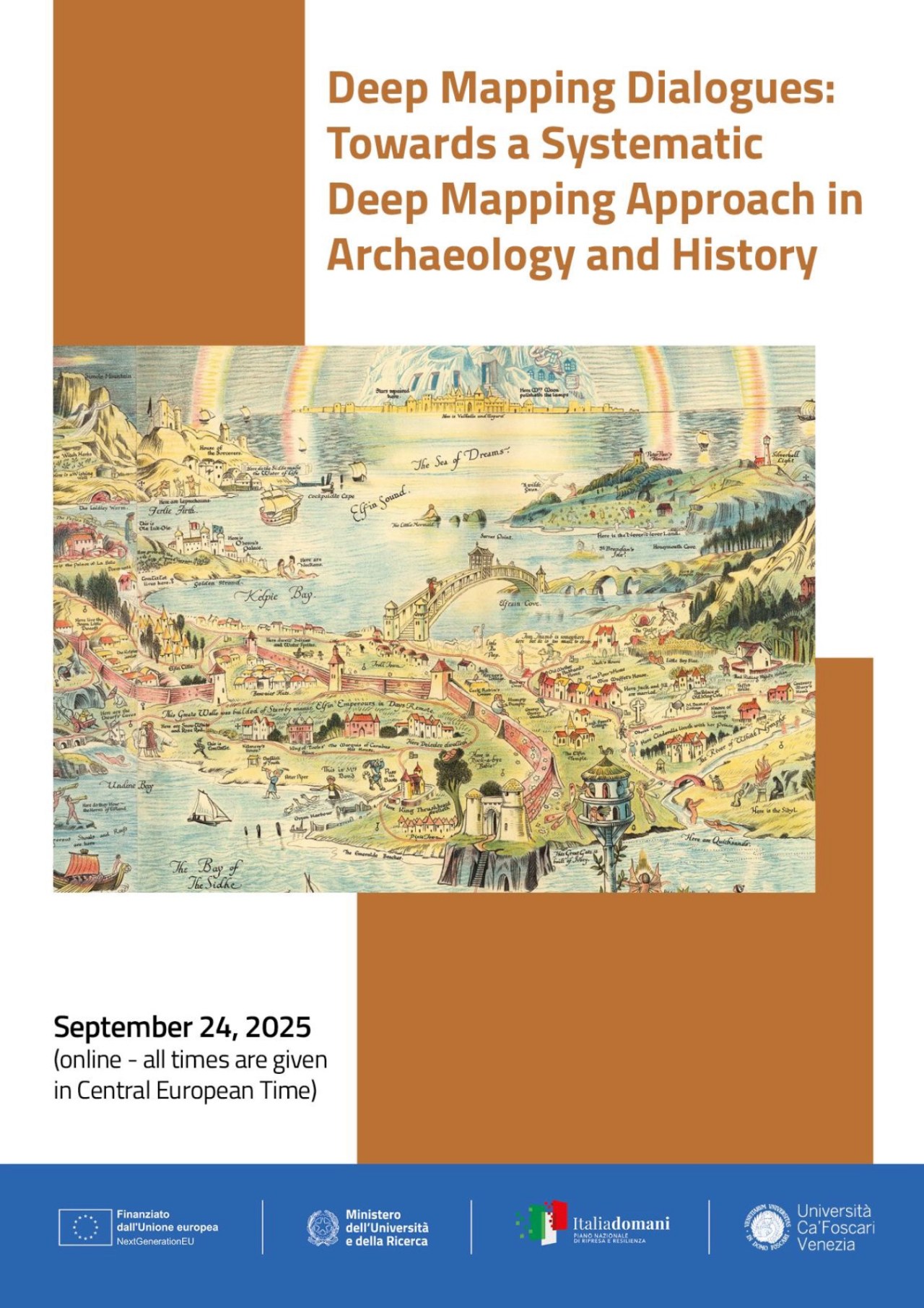I’m in a workshop about Deep Mapping, delivering the opening keynote. A fascinating gathering (Venice and online), organized by Cristina Manzetti (University of Cyprus), and Valentina Mignosa (Ca’ Foscari University of Venice, Digital and Public Humanities (VeDPH).
The topic is an old favorite of mine, developed in my theatre/archaeology with Cliff McLucas and Mike Pearson from the early 90s. It is inspiring to see how a great concept has flourished, and with much potential when we are more-then-ever concerned with our relationships with environment, with milieu.

Maps — diagrams that bring together different kinds of information connected with space and place, land and topography. They can help us navigate and get around. They can be used to administer, manage, and control. They can be sparse and targeted (a map of a city transport system), or rich in information that offers many possible uses (the digital maps on our smart mobile media devices).
Topics explored by the contributing members of the symposium were archives and their organization though spatial information; multimodal, multipurpose and multivoiced maps; digital transformations offered by the likes of GIS; the relationships of maps to community and purpose; and processes of mapping, what and who gets involved. Some studies took us back to antiquity (Pausanias’s tourist-guide itineraries, his periegesis, for example), some looked to the future of cultural mapping. Some questioned just what a map might be.
For me, this was an opportunity to reflect and sum up some personal projects, to figure out just what I might be doing in the way of deep mapping, and looking ahead, on the basis of this summation.
I have elsewhere shared some of the anxiety I have long experienced with mapping, for as long as I can recall — an anxiety of deciding just what to put on a map [Link]. A fascination as well as an anxiety. By the 90s I had teamed up with Cliff McLucas and Mike Pearson, art directors of Brith Gof Theatre, in what we called deep mapping. Brith Gof devised site specific works, on location, in a village chapel, a disused quarry, deep in a forest plantation, on the streets of Cardiff city, and not in theatres. We took our lead from William Least Heat-Moon’s PrairyErth: (a Deep Map) (1991), his dense, layered account of Chase County, Kansas USA. And from early modern antiquarian exploration, with its chorographic impulse to bring together everything you might ever want to say about a place — a personal favorite is John Wallis’s Natural HIstory and Antiquites of the County of Northumberland (1768). Based in west Wales and with an eye on the disunity of a so-called United Kingdom, our focus was quite explicitly upon experiences of inhabitation and authority, of ownership and dispossession.
Deep Mapping — some features
Deep mapping embraces polyvocality and juxtaposition: farmer’s stories beside geological strata, personal journeys beside archival documents. It is performative and unfinished: more an encounter with place than a report on it. It shows how a map can be text, event, and archive all at once — a rehearsal of layered meanings rather than a fixed representation.
Deep Mapping — a definition
Deep mapping is the layering, in performed event, of traces, memories, and narratives into open, polyvocal cartographies that expose the entangled pasts and presents of place while rehearsing possible futures.
So what?
Deep mapping matters because it refuses the map as a tool of control and turns it into a stage for memory, encounter, and imagination. It doesn’t close things down with coordinates and boundaries. Instead, it layers fragments, voices, and times together — archive and anecdote, ruin and invention, the personal and the political.
Its power lies in showing that places are never singular. They are always contested, always polyphonic, always unfinished. In this sense, deep mapping is both critique and creation: it exposes how power inscribes itself into landscapes, but also opens space for other stories, other futures.
Looking forward, deep mapping offers a different cartographic imagination at a time when GIS, data visualisation, and heritage industries dominate how we picture land. It can be pragmatic — a way for communities to articulate identity and negotiate heritage. Performative — through walks, itineraries, and storytelling. Speculative — layering pasts into presents to prototype possible futures. And Transdisciplinary, surpassing academic and professional fields of expertise — drawing artists, archaeologists, geographers, social scientists, earth scientists, natural historians, environmentalists, and citizens in body politic into shared experiments.
Where does this take us? Toward maps as conversations, not statements. Toward practices that help us live with complexity and contradiction. Toward methods of staying with the trouble — rehearsing how we might inhabit landscapes marked by loss, conflict, and resilience, while keeping open the possibility of renewal.
A creative pragmatics for acting with the world [Link] [Link]
Here’s my keynote.
Deep-Mapping-A-Keynote-survey-in-Theatre-ArchaeologyAnd here are the abstracts – such a rich repertoire.
DeepMappingDialogues_abstracts
“Suddenly, over the slope, as if tethered to a cord of air drawing quickly upward, came a Northern Harrier, motionless but for its rising. … If I could be that hawk for one hour I’d never again be just a man.”
— William Least Heat-Moon
That moment speaks to the aspiration of deep mapping: to transcend narrow human perspective, to attune to place in a more expansive register, and to let landscape, memory, and inhabitation reconfigure how we see ourselves.
